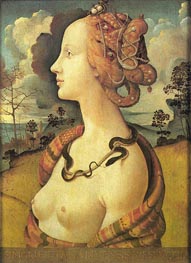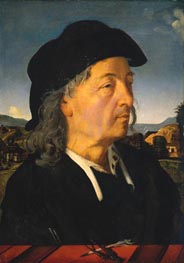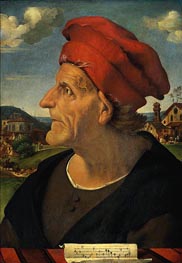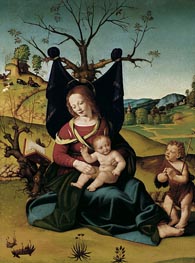
Piero di Cosimo Painting Reproductions 1 of 1
c.1462-1521
Italian High Renaissance Painter
Piero di Cosimo (also known as Piero di Lorenzo) (1462–1521) was an Italian painter. The son of a Florentine goldsmith, he apprenticed under the mediocre Cosimo Rosseli, from whom he he derived is popular name and whom he assisted in the painting of the Sistine Chapel in 1481.
In the first phase of his career, Piero was influenced by the Nordic naturalism of Hugo van der Goes, whose Portinari Altarpiece (now at the Spedale of Santa Maria Novella in Florence) helped to lead the whole of Florentine painting into new channels. From him, most probably, Cosimo acquired the love of landscape and the intimate knowledge of the growth of flowers and of animal life. The manner of Hugo van der Goes is especially apparent in the Adoration of the Shepherds, at the Berlin Museum.
He journeyed to Rome in 1482 with his master, Rosselli. He proves himself a true child of the Renaissance in such pictures as the Venus, Mars, and Cupid, The Death of Procris, the Perseus and Andromeda series, at the Uffizi, and many others. Inspired to the Vitruvius' account of the evolution of man, Piero's mythical compositions show the bizarre presence of hybrid forms of men and animals, or the man learning to use fire and tools. The multitudes of nude in these works shows the influence of Luca Signorelli on Piero's art.
If, as Vasari asserts, he spent the last years of his life in gloomy retirement, the change was probably due to Savonarola, under whose influence he turned his attention once more to religious art. The Immaculate Conception with Saints, at the Uffizi, and the Holy Family, at Dresden, best illustrate the religious fervour to which he was stimulated by the stern preacher.
With the exception of the landscape background in Rosselli's fresco of the Sermon on the Mount, in the Sistine Chapel, we have no record of any fresco work from his brush. On the other hand, Piero enjoyed a great reputation as a portrait painter: the most famous of his work is in fact the portrait of a Florentine noblewoman, Simonetta Vespucci, mistress of Giuliano de Medici. According to Vasari Piero excelled in designing pageants and triumphal processions for the pleasure-loving youths of Florence, and gives a vivid description of one such procession at the end of the carnival of 1507, which illustrated the triumph of death. Piero di Cosimo exercised considerable influence upon his fellow pupils Albertinelli and Bartolomeo della Porta, and was the master of Andrea del Sarto. He was found dead at the foot of a flight of stairs.
In the first phase of his career, Piero was influenced by the Nordic naturalism of Hugo van der Goes, whose Portinari Altarpiece (now at the Spedale of Santa Maria Novella in Florence) helped to lead the whole of Florentine painting into new channels. From him, most probably, Cosimo acquired the love of landscape and the intimate knowledge of the growth of flowers and of animal life. The manner of Hugo van der Goes is especially apparent in the Adoration of the Shepherds, at the Berlin Museum.
He journeyed to Rome in 1482 with his master, Rosselli. He proves himself a true child of the Renaissance in such pictures as the Venus, Mars, and Cupid, The Death of Procris, the Perseus and Andromeda series, at the Uffizi, and many others. Inspired to the Vitruvius' account of the evolution of man, Piero's mythical compositions show the bizarre presence of hybrid forms of men and animals, or the man learning to use fire and tools. The multitudes of nude in these works shows the influence of Luca Signorelli on Piero's art.
If, as Vasari asserts, he spent the last years of his life in gloomy retirement, the change was probably due to Savonarola, under whose influence he turned his attention once more to religious art. The Immaculate Conception with Saints, at the Uffizi, and the Holy Family, at Dresden, best illustrate the religious fervour to which he was stimulated by the stern preacher.
With the exception of the landscape background in Rosselli's fresco of the Sermon on the Mount, in the Sistine Chapel, we have no record of any fresco work from his brush. On the other hand, Piero enjoyed a great reputation as a portrait painter: the most famous of his work is in fact the portrait of a Florentine noblewoman, Simonetta Vespucci, mistress of Giuliano de Medici. According to Vasari Piero excelled in designing pageants and triumphal processions for the pleasure-loving youths of Florence, and gives a vivid description of one such procession at the end of the carnival of 1507, which illustrated the triumph of death. Piero di Cosimo exercised considerable influence upon his fellow pupils Albertinelli and Bartolomeo della Porta, and was the master of Andrea del Sarto. He was found dead at the foot of a flight of stairs.
4 Piero di Cosimo Paintings

Portrait of Simonetta Vespucci before 152
Oil Painting
$1937
$1937
Canvas Print
$67.04
$67.04
SKU: CPD-3154
Piero di Cosimo
Original Size: 57 x 42 cm
Musee Conde, Chantilly, France
Piero di Cosimo
Original Size: 57 x 42 cm
Musee Conde, Chantilly, France

Portrait of Giuliano da San Gallo c.1500
Oil Painting
$1370
$1370
Canvas Print
$61.75
$61.75
SKU: CPD-3155
Piero di Cosimo
Original Size: 47.5 x 33.5 cm
Rijksmuseum, Amsterdam, Netherlands
Piero di Cosimo
Original Size: 47.5 x 33.5 cm
Rijksmuseum, Amsterdam, Netherlands

Portrait of Francesco Giamberti, Cabinetmaker c.1482
Oil Painting
$1869
$1869
Canvas Print
$61.75
$61.75
SKU: CPD-3156
Piero di Cosimo
Original Size: 47.5 x 33.5 cm
Rijksmuseum, Amsterdam, Netherlands
Piero di Cosimo
Original Size: 47.5 x 33.5 cm
Rijksmuseum, Amsterdam, Netherlands

Madonna with Child and the Young St John c.1505/10
Oil Painting
$3165
$3165
Canvas Print
$69.60
$69.60
SKU: CPD-4209
Piero di Cosimo
Original Size: 72 x 54 cm
Liechtenstein Museum, Vienna, Austria
Piero di Cosimo
Original Size: 72 x 54 cm
Liechtenstein Museum, Vienna, Austria